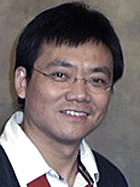A better drug for osteoporosis wouldn’t just preserve patients’ old bone structure; it would help fortify their weakened bones with new bone material. Such a drug could be on the horizon because of research at the School of Medicine that has uncovered new information about how to amplify the bone formation process.
In an upcoming issue of Nature Medicine, Fanxin Long, Ph.D., and colleagues report that knocking out a powerful molecular signaling mechanism within the bones of laboratory mice markedly enhanced bone buildup. The researchers are already investigating drugs that might duplicate that effect. Their aim is to find compounds that help restore healthy density to overly porous bones.

“Right now, bisphosphonates — drugs that slow bone breakdown — are the mainstays of therapeutics for osteoporosis,” said Long, assistant professor of medicine in the Division of Bone and Mineral Diseases and of developmental biology. “But these drugs don’t enhance bone buildup, so the microarchitecture of the bone isn’t restored if tiny fractures or defects develop. Over the long term, they can lead to brittle bones.”
Normally, bones are maintained in a healthy state throughout life by a careful balance between the activity of two kinds of bone cells — osteoblasts that deposit collagen and minerals in bone and osteoclasts that dissolve collagen and minerals. When osteoclasts are the more active cells, bone mass can decrease and osteoporosis can result.
The National Organization for Osteoporosis states that one in two women and one in four men over 50 will eventually suffer an osteoporosis-related fracture.
Bisphosphonates, marketed under the brand names Fosamax, Boniva and Actonel, work by inhibiting osteoclasts. Only one FDA-approved drug, Forteo, a synthetic version of human parathyroid hormone, is designed to stimulate bone formation. The drug has to be injected daily, making it difficult to administer.
“My lab is interested in identifying reagents that will stimulate primitive cells in the bone to become osteoblasts, the cells that add new bone material,” Long said. “There is clearly a need for these types of reagents for osteoporosis treatment.”
A breakthrough came while the researchers were studying how immature bone cells turn into osteoblasts. They were interested in a particular molecular messenger, called Notch, that directs the maturation of many kinds of immature cells.
The scientists developed mice that had no Notch in their bones and saw that their bones grew much denser than usual because the number of osteoblasts increased threefold. Further testing confirmed that Notch inhibits the development of immature bone marrow cells into osteoblasts, a fact that was not known before.
“By removing Notch, we pushed precursor cells within the bone marrow to become osteoblasts,” Long said.
Long cautioned that sustained inhibition of Notch in the bone marrow can also rev up osteoclast production. This was previously shown in a research collaboration between Long; Steven Teitelbaum, M.D., the Wilma and Roswell Messing Professor of Pathology and Immunology; Raphael Kopan, Ph.D., professor of developmental biology, and colleagues, published in the Journal of Biological Chemistry in December 2007.
“It’s possible that giving a Notch inhibitor at a low dose or for a short time could stimulate bone formation without overly increasing bone resorption,” Long said.
Long said drugs are already in development that can interfere with Notch signaling.
“There is a robust effort to develop chemicals that inhibit one of the enzymes in the Notch pathway because the same enzyme is implicated in Alzheimer’s disease,” he said.
Working through the University’s Office of Technology Management, Long has filed for a patent for the use of Notch chemical inhibitors to stimulate bone formation.